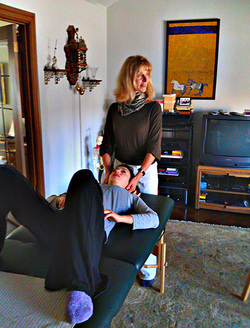Alexander Technique Lessons
Lessons are approximately 45 minutes and cost $50. Sliding scale available.
You should wear comfortable clothes, preferably pants, that allow for easy movement.
Movements are as simple as as sitting and standing. Those with less mobility can lie down.
Lessons available in San Jose. South Bay and Peninsula.
You should wear comfortable clothes, preferably pants, that allow for easy movement.
Movements are as simple as as sitting and standing. Those with less mobility can lie down.
Lessons available in San Jose. South Bay and Peninsula.

Sally Porter Munro working with a trainee at the table in San Francisco. Sally is a senior teacher at the Northern California Center for the Alexander Technique and sings with the San Francisco Opera Chorus.

George Lister, Training Course Director at NCCAT, works with Thalia in the
chair. George recently stated, "I think everyone could benefit from
Alexander lessons."
What is the Alexander technique?
By Walter Carrington.
The Alexander technique is a method of self-help. Its purpose is to help people to avoid doing things that are harmful to their general well-being. The method is unique because, unlike most systems that advise people what to do or how to do it, this teaches what not to do and how to prevent it. Thus, the technique requires, first of all, a practical demonstration, conveying the experience of what actions are wrong; and then clear instruction as to how they can be avoided.
The technique originated as long ago as 1894 from the experiences gained by FM Alexander concerning his use of voice, as an actor and performer of dramatic recitations. He had no scientific training in anatomy and physiology, but observation and experiment led him to acquire knowledge so that he was able to overcome the problems of speech and respiration that had beset him. When certain eminent scientists subsequently experienced his work for themselves, they asserted that it satisfied all the criteria of scientific method.
Why then is the Alexander technique so difficult to describe in simple words? Why, on reading accounts of it, do literate and scientifically educated people often fail to grasp its significance?
On the one hand, the concept of "not to do.", of "thou shalt not", can evoke negative emotional responses which confuse the issue. People prefer to be advised what to do. They look for positive instruction. On the other hand,
the scientific significance of what Alexander observed as he stood in front of a looking glass can scarcely be appreciated by a reader without some technical knowledge of balance, movement and posture.
He established empirically that in posture and movement his neck must not be stiffened, but that his head should be allowed to adopt a certain preferred attitude in relation to his neck and body (described by him as "head
forward and up" and that this was consistent with the free, alert, attitude or state of poise.
Recent scientific research concerning head orientation and posture in invertebrates indicates that there is
a preferred head orientation, which animals maintained through a variety of behaviors. It is associated with an alert posture and an extensive acrobatic capability. In living vertebrates it involves maintaining the semicircular canals, or the lateral semicircular canal (a part of the organ of balance or the vestibular apparatus), in an attitude approximately level with the horizon.
Research in the neurophysiology of balance, posture and locomotion is of comparatively recent origin, but so far as it has gone it tends to confirm Alexander's empirical findings and should lead ultimately to an understanding and acceptance of his Technique.*
For another take on the definition of the Alexander technique, see http://www.alexandertechnique.com/.
Biographical note: Walter H. M. Carrington (1915 – 2005) trained with FM Alexander 1936 – 39. He worked at Alexander's teachers training course 1946 – 55 and continued running the training course after Alexander's death, from 1960 onwards known as the Constructive Teaching Centre. He lectured and wrote extensively on the technique, and many of his lectures and several interviews have been published. His comprehensive
knowledge and memory of the history of the technique was paramount in preserving information and recollections of FM Alexander.**
* and ** The above quote from Walter Carrington and the biographical note
from the DVD package "FM Alexander 1949 – 1950", copyright 2010, Mouritz, United
Kingdom.
forward and up" and that this was consistent with the free, alert, attitude or state of poise.
Recent scientific research concerning head orientation and posture in invertebrates indicates that there is
a preferred head orientation, which animals maintained through a variety of behaviors. It is associated with an alert posture and an extensive acrobatic capability. In living vertebrates it involves maintaining the semicircular canals, or the lateral semicircular canal (a part of the organ of balance or the vestibular apparatus), in an attitude approximately level with the horizon.
Research in the neurophysiology of balance, posture and locomotion is of comparatively recent origin, but so far as it has gone it tends to confirm Alexander's empirical findings and should lead ultimately to an understanding and acceptance of his Technique.*
For another take on the definition of the Alexander technique, see http://www.alexandertechnique.com/.
Biographical note: Walter H. M. Carrington (1915 – 2005) trained with FM Alexander 1936 – 39. He worked at Alexander's teachers training course 1946 – 55 and continued running the training course after Alexander's death, from 1960 onwards known as the Constructive Teaching Centre. He lectured and wrote extensively on the technique, and many of his lectures and several interviews have been published. His comprehensive
knowledge and memory of the history of the technique was paramount in preserving information and recollections of FM Alexander.**
* and ** The above quote from Walter Carrington and the biographical note
from the DVD package "FM Alexander 1949 – 1950", copyright 2010, Mouritz, United
Kingdom.
[email protected] 408-998-9490 San Jose, CA